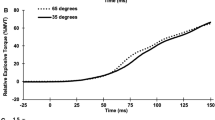Abstract
Electromechanical delay (EMD) in isometric contractions of knee extensors evoked by voluntary, tendon reflex (TR) and electrical stimulation (ES) was investigated in 21 healthy young subjects. The subject performed voluntary knee extensions with maximum effort (maximal voluntary contraction, MVC), and at 30%, 60% and 80% MVC. Patellar tendon reflexes were evoked with the reflex hammer being dropped from 60°, 75° and 90° positions. In the percutaneous ES evoked contractions, single switches were triggered with pulses of duration 1.0 ms and of intensities 90, 120 and 150 V. Electromyograms of the vastus lateralis and rectus femoris muscles were recorded using surface electrodes. The isometric knee extension force was recorded using a load cell force transducer connected to the subject's lower leg. The major finding of this study was that EMD of the involuntary contractions [e.g. mean 22.1 (SEM 1.32) ms in TR 90°; mean 17.2 (SEM 0.62) ms in ES 150 V] was significantly shorter than that of the voluntary contractions [e.g. mean 38.7 (SEM 1.18) ms in MVC,P < 0.05]. The relationships between EMD, muscle contractile properties and muscle fibre conduction velocity were also investigated. Further study is needed to explain fully the EMD differences found between the voluntary and involuntary contractions.
Similar content being viewed by others
References
Aura O, Komi PV (1987) Effects of muscle fibre distribution on the mechanical efficiency of human locomotion. Int J Sports Med Suppl 8:30–37
Basmajian JV, De Luca CJ (1985) Muscle alive: their functions as revealed by electromyography, 5th edn. Williams and Wilkins, Baltimore, Md., p 68
Bell DG, Jacobs I (1986) Electro-mechanical response times and rate of force development in males and females. Med Sci Sports Exerc 18:31–36
Binder MD, Bawa, P, Ruenzel P, Henneman E (1983) Does orderly recruitment of motoneurons depend on the existence of different types of motor units? Neurosci Lett 36:55–58
Broman H, Bilotto G, De Luca CJ (1985) Myoelectric signal conduction velocity and spectral parameters: influence of force and time. J Appl Physiol 58:1428–1473
Burke RE (1973) On the central nervous system control of fast and slow twitch motor units. In: Desmedt JE (ed) New development in electromyography and clinical neurophysiology 3:69–94
Cabric M, Appell HJ (1987) Effect of electrical stimulation of high and low frequency on maximum isometric force and some morphological characteristics in men. Int J Sports Med 8:256–260
Cavanagh PR, Komi PV (1979) Electromechanical delay in human skeletal muscle under conentric and eccentric contractions. Eur J Appl Physiol 42:159–163
Clarkson PM, Kroll W (1978) Practice effects on fractionated response time related to age and activity level. J Motor Behav 10:275–286
Grabiner MD (1986) Bioelectric characteristics of the electromechanical delay preceding concentric contraction. Med Sci Sports Exerc 18:37–43.
Grabiner MD, Jaque V (1987) Activation patterns of the triceps brachii muscle during sub-maximal elbow extension. Med Sci Sports Exerc 19:616–62
Grimby L (1987) Motor unit recruitment during normal locomotion. Med Sport Sci 26:142–151
Häkkinen K, Komi PV (1983) Changes in neuromuscular performance in voluntary and reflex contraction during strength training in man. Int J Sports Med 4:282–288
Henneman E, Somjen G, Carpenter DO (1965a) Excitability and inhibility of motoneuron of different sizes. J Neurophysiol 28:599–620
Henneman E, Somjen G, Carpenter DO (1965b) Functional significance of cell size in spinal motoneurons. J Neurophysiol 28:560–580
Horita T, Ishiko T (1987) Relationships between muscle lactate accumulation and surface EMG activities during isokinetic contractions in man. Eur J Appl Physiol 56:18–23
Hultman E, Sjöholm H, Jäderhol Ek I, Krynicki J (1983) Evaluation of methods for electrical stimulation of human skeletal muscle in situ. Pflügers Arch 398:139–141
Kroll W (1974) Fractionated reaction and reflex time before and after fatiguing isotonic exercise. Med Sci Sports 6:260–266
Moritani T, Berry MJ, Bacharach DW, Nakamura E (1987) Gas exchange parameters, muscle blood flow and electromechanical properties of the plantar flexors. Eur J Appl Physiol 56:30–37
Moss CL (1991) Comparison of the histochemical and contractile properties of human gastrocnemius muscle. J Orthop Sports phys Ther 13:322–328
Muro M, Nagata A (1985) The effects on electromechanical delay of muscle stretch of the human triceps surae. In: Winter DA, Norman RW, Wells RP, Hayes KC, Patla AE (eds) Biomechanics IX-A. Human Kinetics, Champaign, pp 86–90
Nilsson J, Tesch P, Thorstensson A (1977) Fatigue and EMG of repeated fast voluntary contractions in man, Acta Physiol Scand 101:194–198
Norman RW, Komi PV (1979) Electromechanical delay in skeletal muscle under normal movement conditions. Acta physiol Scand 106:241–248
Sadoyama T, Masuda T, Miyata H, Katsuta S (1988) Fibre conduction velocity and fibre composition in human vastus lateralis. Eur J Appl Physiol 57:767–771
Shorten MR (1987) Muscle elasticity and human performance. Med Sport Sci 25:1–18
Solomonow M (1984) External control of the neuromuscular system. IEEE Trans Biomed Eng 31:752–763
Viitasalo JT, Komi PV (1981) Interrelationships between electromyographical, muscle structure and reflex time measurements in man. Acta Physiol Scand 111:97–103
Vos EJ, Mullender MG, Van Ingen Schenau GJ (1990) Electromechanical delay in the vastus lateralis muscle during dynamic isometric contractions. Eur J Appl Physiol 60:467–471
Vos EJ, Harlaar J, Van Ingen Schenau GJ (1991) Electromechanical delay during knee extensor contractions. Med. Sci Sports Exerc 23:1187–1193
Wigerstad-Lossing I, Grimby G, Jonsson T, Morelli B, Peterson L, Renstrom P (1988) Effects of electrical muscle stimulation combined with voluntary contractions after knee ligament surgery. Med Sci Sports Exerc 20:93–98
Winter EM, Brookes FBC (1990) Electromechanical response times and muscle elasticity. J Physiol 429:106P
Zhou S (1994) Electromechanical delay of knee extensors: the normal range and the effects of exercise. Ph.D. thesis, University of Melbourne, Australia
Author information
Authors and Affiliations
Rights and permissions
About this article
Cite this article
Zhou, S., Lawson, D.L., Morrison, W.E. et al. Electromechanical delay in isometric muscle contractions evoked by voluntary, reflex and electrical stimulation. Eur J Appl Physiol 70, 138–145 (1995). https://doi.org/10.1007/BF00361541
Accepted:
Issue Date:
DOI: https://doi.org/10.1007/BF00361541




